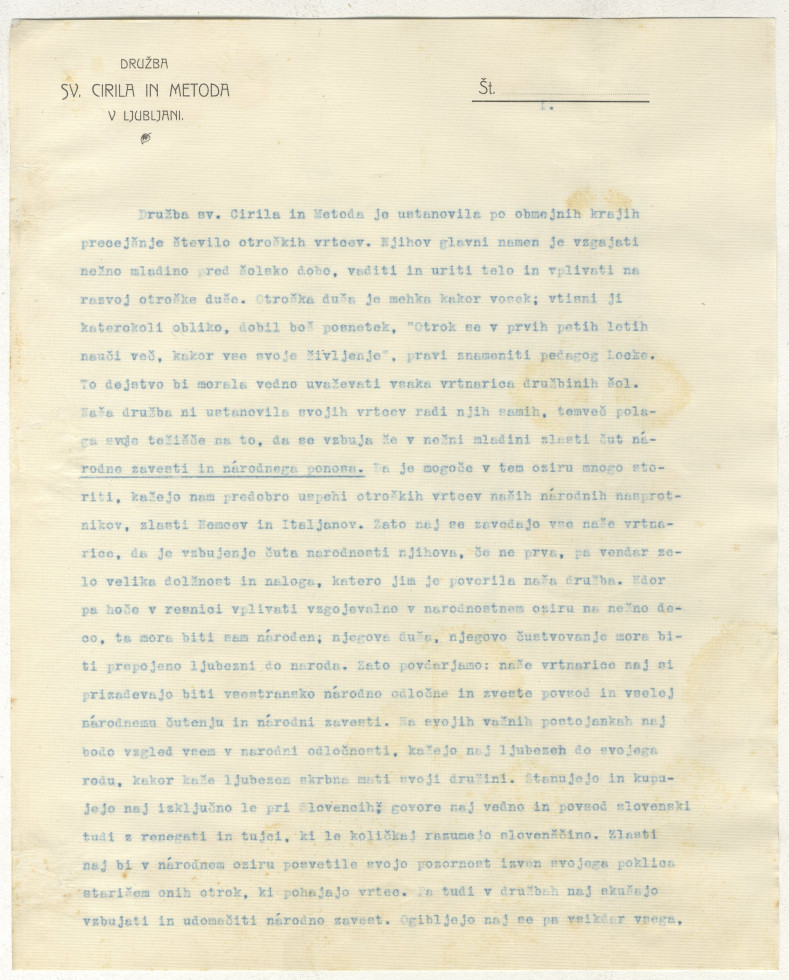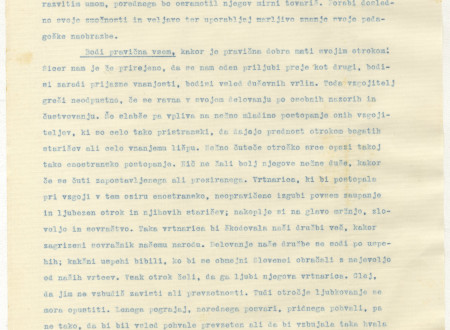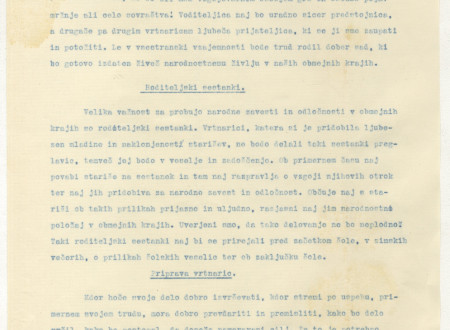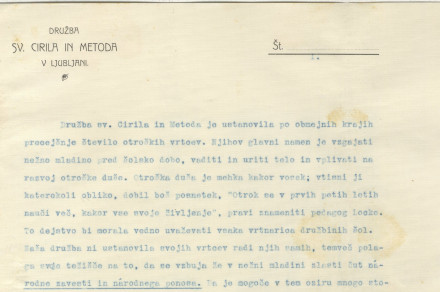Instruction for Work in the Kindergartens of the St. Cyril and Methodius Society
National defence and educational organization of St. Cyril and Methodius Society
Throughout its entire existence, the national defence and educational organization of St. Cyril and Methodius Society (founded in 1885) strove to preserve the Slovene language and culture and to contribute to the development of the Slovenian school system. For this purpose, the society founded or financially supported Slovenian kindergartens and people’s (national) schools abroad and in multi-ethnic areas of Carniola, Littoral, Carinthia and Styria. When after the First World War one third of the Society’s Carinthian and Trieste branch offices remained in Austria and Italy, the Society began to support public schools in Kočevska and Prekmurje regions.
Kindergartens as pre-school educational institutions began to be founded in the second half of the 19th century, after the adoption of the Primary Education Act in 1869, and were modelled on those developed by Friedrich Fröbel. This German pedagogue was a firm advocate of the education that was accordant with nature and four basic instincts; work, learning, art, and piety. He introduced the concept of structured and guided play in learning (seeing play as essential for the development of children), developed the methodology for work in kindergartens, and emphasized the irreplaceability of family upbringing in a child’s pre-school period.
St. Cyril and Methodius Society was aware of the importance of early raising of national consciousness among pre-school children and in 1886 opened its first kindergarten in Celje, followed by a number of others in Trieste and Gorizia region, in Maribor, Hrastnik, Ormož, Tržič, and Jesenice. Pre-school educational programme in kindergartens was carried out by kindergarten vrtnarice (as the 19th century kindergarten teachers were referred to). Like today, they were the ones who played the most important role in carrying out pre-school educational programme, and a special work instruction was issued for them by the Society. In the archival fonds of the St. Cyril and Methodius Society, kept by the Archives of the Republic of Slovenia, one copy of such instruction has been preserved. Judging from the writing on the back of the typescript, the instruction was prepared by Fran Skulj. In the introduction, the author stresses the importance of developing a sense of national consciousness already among children of a tender young age and the importance of lifelong education of kindergarten teachers. The second part instructs how to communicate with children and the third part discusses the goals of individual subjects and educational methods. The final provisions deal with the obligations of the teachers and their cooperation with children’s parents. They also discuss how teachers should prepare for their work, and state the list of records that each kindergarten should keep. The instruction provides a valuable insight into the educational methods of that time, and it also points out the values that the Society believed in and fought for.
According to the instruction, teachers had to be nice to children (Love conquers all obstacles and if children love you, they obey you), they had to realize that they were a child’s substitute mother for part of the day, so they had to carefully observe the children in order to get to know them and know how to direct them (Once you get to know the individuality of the children that were placed in your care, you can interact in a positive and gentle manner with them. It is easier for you to help them give up their habits that you have observed; their virtues you must commend and use in further education). Their treatment of children should be as unbiased as possible (Be just with all … even more devastating for the youngsters is the effect of those teachers who are so biased that they discriminate in favour of children of wealthier parents or in favour of appearance), they should be able to determine if a child was acting inappropriately, whether intentionally or unknowingly (Don’t judge too quickly!), and they should always act decently (When needed, be serious! You can show your bad mood, but you should never let your anger or even rage get the best of you. Avoid shouting and screaming! Be lively, happy! And another thing: When you punish, conduct yourself with dignity so that a child can feel your authority and worth … Also, punishment should be a rare exception and not an everyday occurrence).
Kindergarten teachers did not teach catechesis, but they did nourish children’s sense of religion and their respect and love for their ruler. They also taught them how to properly and respectfully cross themselves and say the Lord’s prayer and Hail Mary. By means of conversation practice the teachers played an active part in developing children’s literary language and encouraged their love of mother tongue (Like we love our mother we also love our language. Whoever despises or shames our language, shames our mother as well). The method used by teachers when working with children was conversation practice during which the teachers had to use proper Slovene, avoid using foreign words, and demand that children answer their questions with short, well-structured sentences. They cultivated the sound of beautiful Slovene language by reading content and age appropriate Slovene folk tales and stories (/…/ you need to be careful to select stories that stir tender feelings in young hearts, feelings such as compassion, kindness, goodness, etc.). Children trained their memory by learning poems and songs by heart. Playing, exercise and outdoor activities were also important part of the educational process. Children were taken outside if weather permits and were taught to learn about and respect nature (Teach them that it is not right to destroy plants and torture animals).
It is difficult to assess to what extend this instruction, whose educational and methodological values we can still appreciate today, affected the work of kindergarten teachers. Based on the preserved records of the Society, which include letters of complaints, records on disciplinary proceedings, dismissal of teachers and their transfers to new posts, we can see that the instruction was sometimes a success, and sometimes not so much.
Danijela Juričić Čargo





